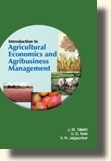
|
Introduction to Agricultural Economics and Agribusiness Management - J. M. Talathi |
Author |
J. M. Talathi
V. G. Naik
V. N. Jalgaonkar
|
|
Cover Price : Rs 995.00
|
Imprint : Ane Books Pvt. Ltd.
ISBN : 9789388264853
YOP : 2019
|
Binding : Hardbound
Size : 6.25" X 9.50"
Total Pages : 176
CD : No
|
|
About the Book :-
The students of agricultural economics should have clear insight and understanding of intricacies involved in agricultural sector.
The developing economy characteristics in India reveal the heavy dependence of its economy on agriculture. In the post independence era, India has had some great achievements on the production side of agriculture that has given good encouragement to Agribusiness development. The Agribusiness is influenced by a variety of factors such as number of Agribusiness firms, rapport between Agribusiness firms, seasonality in agricultural production and their impact on market behaviour and government and international policies.
Thus, understanding Agribusiness sector is extremely important and its success would depend on a clear and focussed vision with immaculate organizational planning.
The main focus of this book is to explain the concept of Agribusiness management in simplified manner so that the students of Agricultural Economics can understand the intricacies involved in this sector and find alternatives for better development.
Contents :-
Part-I: Introduction to Agricultural Economics; 1. Introduction to Economics 2. Agricultural Economics 3. Consumption, Wants and their Characteristics 4. Standard of Living 5. Laws of Consumption 6. Production and Factors of Production 7. Concept of National Income 8. Public Finance 9. Characteristics of Agriculture and Industry 10. Agricultural Holding 11. Land Tenure Systems 12. Farm Mechanisation, Part-II: Agribusiness Management; 13. Agricultural Business Management 14. Forms of Business Organisation 15. Production Relationships 16. Cost Concept 17. Farm Planning 18. Agricultural Marketing 19. Agribusiness and Balance Sheet Analysis 20. Project Preparation 21. Role of Agro-processing in Agribusiness Development, Bibliography, Index
About the Authors :-
Dr. Jeevankumar Motiram Talathi is Professor of Agricultural Economics at the College of Agriculture, Dr. Balasaheb Sawant Konkan Krishi Vidyapeeth, Dapoli, Dist. Ratnagiri. He is having teaching experience of more than 25 years at under graduate and post graduate level in Agricultural Economics. He has guided 15 students for M.Sc. (Agri.) and 2 students for Ph.D. in Agricultural Economics. His Ph.D. research was on “An Economic analysis of Investment for Sustainable Exploitation of Groundwater in Konkan region (M.S.)”. He has published around 100 research articles in international and national journals and also published more than 25 extension articles for benefit of farming community. He is a life member for seven professional bodies. Presently, he is nominated on the editorial board of International Journal of Agricultural Sciences and recognized fellow of Hind-Agri Horticultural Society. Muzaffarnagar (U.P.). His major areas of interest are Agribusiness Management and Agricultural Project analysis.
Dr.Vitthal Govind Naik is presently working as Assistant Professor of Agricultural Economics at College of Agriculture, Dr. Balasaheb Sawant Konkan Krishi Vidyapeeth, Dapoli, Dist. Ratnagiri. He has 15 years experience of teaching at undergraduate and postgraduate level. He has published around thirty research papers in international and national journals and guided 8 students for M.Sc. (Agri.) in Agricultural Economics. His Ph.D. research was on “An Economic analysis of Production, Processing and Export of Mango in Konkan region (M.S.)”. His major areas of interest are Agricultural Marketing and Business Management.
Mr.Vinayak Narayan Jalgaonkar, M.Sc. in Agricultural Entomology form Dr. Balasaheb Sawant Konkan Krishi Vidyapeeth, Dapoli. He started his carrier with the private company and after several years of rich experience in marketing and banking, he joined as Junior Entomologist for Cashew Crop at Regional Fruit Research Station, Vengurla in 2004. He was associated with ICAR ad-hoc project Forewarming of Tea Mosquito Bug in Cashew for 7 months as a Co PI and associated with the Directorate of Cashew and Cocoa Development, Cochin. He has to his credit one book entitled “Indian Cashew Processing and Export” 10 research papers, 10 technical papers and 12 popular articles.
|
|
 |

|
AGRICULTURAL PRODUCTION, INDIAN REPRINT - OKORO M. AKINYEMI (EX) |
|
|
Cover Price : Rs 2,495.00
|
Imprint : CRC Press
ISBN : 9781578085125
YOP : 2013
|
Binding : Hardbound
Total Pages : 250
CD : No
|
|
About the Book
This book is an introductory text on the basic principles of organic and coventional production systems.
It dwells on soil management principles and supply of nutrients to crops under cultivation. It explains how soil nutrients can be improved and how pests and diseases can be controlled biologically. The book gives an insight on how to promote ecological farming methods.
The book contains.
- Several clear illustrations
- Relevant photographs
- Results of practical work done in laboratories.
This book will benefit all agricultural science students. |
|
 |
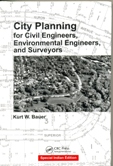
|
CITY PLANNING FOR CIVIL ENGINEERS, ENVIRONMENTAL ENGINEERS, AND SURVEYORS, INDIAN REPRINT - KURT W. BAUER (EX) |
|
|
Cover Price : Rs 3,995.00
|
Imprint : CRC Press
ISBN : 9781439808924
YOP : 2013
|
Binding : Hardbound
Total Pages : 516
CD : No
|
|
While engineers and surveyors are not urban planners, they are often engaged in urban development. Therefore, a high degree of competence in civil engineering specialties such as surveying and mapping, highway and transportation engineering, water resources engineering, environmental engineering, and, particularly, municipal engineering requires an understanding of urban development problems and urban planning objectives, principles, and practices. With this in mind, City Planning for Civil Engineers, Environmental Engineers, and Surveyors focuses on areas of urban planning with which civil and environmental engineers and surveyors are most likely to come into contact or conflict, in which engineers and surveyors may be required to participate, and for which engineers may be required to provide necessary leadership.
The text stresses basic concepts and principles of practice involved in urban planning as most widely practiced, particularly in small and medium-sized communities. It introduces engineering students to land-use planning as a foundation for infrastructure systems planning and development. It also presents plan implementation devices such as zoning, land subdivision control, official mapping, and capital improvement programming. It describes the factors affecting good land subdivision design and improvement. In addition, the text illustrates the importance of good mapping and control surveys for planning purposes. Written from the perspective that cities are social and economic as well as physical entities, the book offers a historical context for urban planning.
There are a large number of texts on the subject of urban planning, but most generally do not address in any comprehensive way the engineering problems encountered in urban planning. This book delineates these problems and stresses the importance of close cooperation between civil engineers and planning professionals to achieving effective urban planning. Armed with this information, practicing engineers and surveyors can become more knowledgeable participants in the urban planning process and more effective members of urban planning teams and governmental and consulting agency staff.
Contents
1 Introduction
2 Definition of Terminology
3 The Historic Context Of Urban Planning in the United States
4 Compilation of Essential Data: A Brief Overview
5 Map Requirements For City Planning
6 Population Data and Forecast
7 Economics Data and Forecasts
8 Land Use and Supporting Infrastructure Data
9 Natural Resource Base Inventories
10 Institutional Structure for City Planning and the Comprehensive Plan
11 Objectives, Principles, and Standards
12 Land Use Planning
13 Neighborhood Unit Concept
14 Principles of Good Land Subdivision Design
15 Street Patterns and Transportation Planning
16 Other Plan Elements
17 Plan Implementation – Land Subdivision Control
18 Plan Implementation - Zoning
19 The Official Map
20 Capital Improvement Programming
Appendix A
Example Land Subdivision Control Ordinance Regulations
Appendix B
Example Zoning Ordinance Regulations
Index
|
|
 |
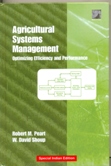
|
AGRICULTURAL SYSTEMS MANAGEMENT, INDIAN REPRINT - ROBERT M. PEART (EX) |
Author |
ROBERT M. PEART
W.DAVID SHOUP
|
|
Cover Price : Rs 3,995.00
|
Imprint : CRC Press
ISBN : 9780824747831
YOP : 2013
|
Binding : Hardbound
Total Pages : 290
CD : No
|
|
About the Book
Offering practical and informative exercises in nearly every chapter, this text/reference presents valuable computer strategies for solutions to challenges commonly faced in agricultural production, processing, and management –utilizing readily available computer programs, spreadsheets, and internet tools to provide clear explanations and obtain optimal in field and livestock operations, machinery selection, and planning and forecasting of crops and yield.
Covers topics that are integral to real-world agricultural system management including precision agriculture, crop and operation simulation, geographic information systems, project scheduling, systems reliability, machinery performance and cost, and linear optimization.
You can apply the techniques illustrated in Agricultural Systems Management to effectively set and handle priorities, allocate resources, generate timelines, and build Data collection programs gain an edge in crop management, simulation of crop yields, projection of harvesting dates, and preparation of market forecasts.. run and enhance agricultural systems at minimal cost…compare total expenses, determine the size and capacity of equipment, and assure timeliness in numerous crop operations such as planting and harvesting… time the application of nutrients and irrigation water for the most efficient use of resources… and solve problems concerning waiting lines and service capacities.
Contents
-Agricultural Systems: A Managerial Overview, W.D. Shoup
-Reliability of Agricultural Systems, W.D. Shoup
-Data Management and Spreadsheet Fundamentals, R.M. Peart
-Fixed and Variable Costs of Machinery and Facilities, R.C. Fluck and R.M. Peart
-Machinery Selection and Management Program for Maize/Soybean, J.C. Siemens and R.M. Peart
-Simulation of Crop Growth and Field Operations: CropPlan, R.M. Peart and R. Smith
-Crop Simulation, R.M. Peart
-Optimizing the Use of Resources: Linear Programming, R.M. Peart and F. Royce
-Queuing Theory and Waiting Line Applications, R.M. Peart
-Project Scheduling, R.M. Peart
-Artificial Intelligence and Decision Support Systems, R.M. Peart
-Precision Technologies for Precision Management, W.D. Shoup, W. Lee, and T. Harrison
Index
About the Authors
Robert M. Peart is Graduate Research Professor Emeritus, Department of Agricultural and Biological Engineering, University of Florida, Gainesville. The editor or coeditor of several books, including Agricultural Systems Modeling and Simulation (Marcel Dekker, Inc.), he is the author of more than 60 scientific papers and holds three patents. A Fellow and former director of the American society of Agricultural Engineers and a member of the American Association for Artificial Intelligence, Dr Peart received the Ph.D.degree (1960) in agricultural engineering from Purdue University, West Lafayette, Indiana.
W.David Shoup is Professor of Agricultural and Biosystems Engineering, Electrical Engineering, and Public Policy, Southern Illinois University, Carbondale. The author of over 450 publications related to food and agricultural systems management, Dr. Shoup has consulted with over 200 companies and corporation in the area of technical and systems management. He is a life member of the American society of Agricultural Engineers, the International Society of Pharmaceutical Engineers, and the National Farmer’s Union. During his career in technical management, Professor Shoup held various management positions for Tenneco Inc. and professorial positions with the university of Florida, University of Arizona, University of Tennessee, and Southern Illinois University. Dr. Shoup received the Ph.D.degree (1980) in agricultural systems from Purdue University, West Lafayette, Indiana.
|
|
 |
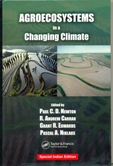
|
AGROECOSYSTEMS IN A CHANGING CLIMATE, INDIAN REPRINT - PAUL C.D. NEWTON (EX) |
Author |
PAUL C.D. NEWTON
R.ANDREW CARRAN
GRANT R. EDWARDS
PASCAL A. NIKLAUS
|
|
Cover Price : Rs 3,995.00
|
Imprint : CRC Press
ISBN : 9780849320880
YOP : 2013
|
Binding : Hardbound
Total Pages : 378
CD : No
|
|
|
Agroecosystems in a Changing Climate considers the consequences of changes in the atmosphere and climate on the integrity, stability, and productivity of agroecosystems. The book adopts a novel approach by bringing together theoretical contributions from ecologists and the applied interpretations of agriculturalists. Combining these two approaches, the book provides the theoretical underpinning that guides scientists on what phenomena to look for beyond first-order responses in the creation of sustainable agroecosystems. This unique approach provides an interpretation of ecological insights and general theory, and then relates them to agroecosystem performance.
Each section of the book combines general principles of response with an examination of the applied consequences. The authors cover the supply of resources necessary to sustain agriculture in the future and discuss the incidence of pests, weeds, diseases, and their control. They provide an understanding of how the population biology of organisms will change and the adaptations that might be possible. The book also explores plant breeding solutions and the capacity for adaptation that exists in plant populations. In addition to the full chapters, the book includes Special Example chapters that deal in more detail with specific issues.
Presenting a global perspective of climate change effects on agricultural production, Agroecosystems in a Changing Climate establishes connections between the immediate effects of change and the longer-term processes that will ultimately determine the consequences for agroecosystems and therefore the potential for adaptation.
Contents
Chapter 1 Introduction
Resource Supply and Demand
Chapter 2 Climate Change Effects on Biogeochemical Cycles Nutrients and Water Supply
Chapter 3 Nutrient and Water Demands of Plants under Global Climate Change
Chapter 4 Climate Change and Symbiotic Nitrogen Fixation in Agroecosystems
Chapter 5 Belowground Food Webs in a Changing Climate
Chapter 6 Herbivory and Nutrient Cycling
Chapter 7 Sustainability of Crop Production Systems under Climate Change
Pests, Weeds, and Diseases
Chapter 8 Plant Performance and Implications for Plant Population Dynamics and Species Composition in a Changing Climate
Chapter 9 Climate Change Effects on Fungi in Agroecosystems
Chapter 10 Trophic Interactions and Climate Change
Chapter 11 Future Weed Pest and Disease Problems for Plants
Capacity to Adapt
Chapter 12 Distinguishing between Acclimation and Adaptation
Chapter 13 Plant Breeding for a Changing Environment
Special Examples
Special Example 1 Impacts of Climate Change on Marginal Tropical Animal Production Systems
Special Example 2 Climate Change and Biological Control
Special Example 3 Efficacy of Herbicides under Elevated Temperature and CO2
Special Example 4 Evolution of Pathogens under Elevated CO2
Special Example 5 Adapting United Kingdom Agriculture to Climate Change
Index
|
|
 |
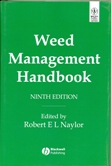
|
WEED MANAGEMENT HANDBOOK , 9TH ED , INDIAN REPRINT - ROBERT E.L. NAYLOR (EX) |
Author |
ROBERT E.L. NAYLOR
|
|
Cover Price : Rs 5,995.00
|
Imprint : Wiley India
ISBN : 9788126537846
YOP : 2013
|
Binding : Hardbound
Total Pages : 432
CD : No
|
|
Weed Management Handbook updates the 8th edition of Weed Control Handbook. The change in the title and contents of the book from previous editions reflects both the current emphasis on producing crops in a sustainable and environmentally-friendly manner, and the new weed management challenges presenting themselves.
This landmark publication contains cutting edge chapters, each written by acknowledged experts in their fields and carefully drawn together and edited by Professor Robert Naylor, known and respected world-wide for his knowledge of the area. The sequence of chapters included reflects a progression from the biology of weeds, through the underpinning science and technology relating to weed management techniques including herbicides and their application to crops, leading to principles of weed management techniques. Finally a set of relevant case studies describes the main management options available and addresses the challenges of reduced chemical options in many crops.
Weed Management Handbook is a vital tool for all those involved in the crop protection / agrochemical industry, including business managers, horticultural and agricultural scientists, plant physiologists, and botanists. As an important reference guide for undergraduate and postgraduate students studying horticultural and agricultural sciences, plant physiology, botany and crop protection, copies of the book should be available on the shelves of all research establishments and universities where these subjects are studied and taught.
Weed Management Handbook is published for the British Crop Protection Council (BCPC) by Blackwell Publishing.
BCPC is a registered charity having the principal objective of promoting the development, use and understanding of effective and sustainable crop protection practice.
Professor Robert E.L. Naylor is a consultant in agriculture, environment and crop protection, based in Banchory, Ecotland, UK.
Contents
Introduction.
1 What is a Weed? (Robert E.L. Naylor and Peter J. Lutman).
2 Weed Competition (R.J. Froud-Williams).
3 What is the Weed Seed Bank? (Andrea C. Grundy and Naomi E. Jones).
4 Weed Population Dynamics (Robert E.L. Naylor).
5 Weeds and Biodiversity (E.J.P. Marshall).
6 Herbicide Discovery (Leonard G. Copping).
7 Herbicide Legislation and Regulation (D.J. Flynn).
8 Herbicides: Modes of Action and Metabolism (John P.H. Reade and A.H. Cobb).
9 Herbicide Formulation and Delivery (Duncan Webb).
10 Methodology of Application (T.H. Robinson).
11 Herbicide-Resistant Weeds (Stephen R. Moss).
12 Herbicide-Tolerant Crops (Ralph C. Kirkwood).
13 Non-chemical Weed Management (W. Bond).
14 Integrated Weed Management (Robert E.L. Naylor and Caroline Drummond).
15 Developing Decision-Support Systems to Improve Weed Management (James Clarke).
16 Optimising Herbicide Performance (Per Kudsk).
17 Biological Control of Weeds (M.P. Greaves).
18 Weed Management Strategies for Winter Cereals (James Clarke).
19 Weed Control in other Arable and Field Vegetable Crops (C.M. Knotf).
20 Management of Aquatic Weeds (Jonathan R. Newman).
21 Where is Weed Management Going? (Robert E.L. Naylor).
Index. |
|
 |
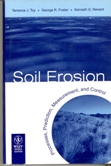
|
SOIL EROSION: INDIAN REPRINT 2013 - TERRENCE J. TOY (EX) |
Author |
TERRENCE J. TOY
GEORGE R. FOSTER
KENNETH G. RENARD
|
|
Cover Price : Rs 3,995.00
|
Imprint : Wiley India
ISBN : 9788126536955
YOP : 2013
|
Binding : Hardbound
Total Pages : 352
CD : No
|
|
A thorough look at physical properties of soil erosion
Soil erosion has been responsible for billions of dollars of damage during the past thirty years, in the United States alone. Soil Erosion provides complete coverage of the physical causes, processes, and effects of this environmental problem from its origins to planning for future conservation and remediation.
This book focuses on the process of soil erosion and erosion-control principles independent of land use. Coverage includes the primary factors that influence soil erosion, various types of erosion, erosion-prediction technology, erosion measurements, erosion and sediment control, and conservation of the land. Practical material on erosion models is featured along with ways to use these models as erosion-control tools. Details of conservation planning and government policy are presented in a historical context, supported by examples of working public programs and technical tools for conservation planning. End-of-chapter summaries and comprehensive appendices on soils, hydrology, and soil-erosion Web sites make this a complete and easy-to-use introduction to soil-erosion processes, prediction, measurement, and control.
Supplemented with more than 100 photographs, drawings, and tables, Soil Erosion: Processes, Prediction, Measurement, and Control is an essential book for students of soil management, erosion, conservation, earth science, civil engineering, and agriculture; employees of soil conservation districts; government employees in the Natural Resources Conservation Service, Forest Service, USDA, EPA, and Bureau of Land Management; and soil scientists
Contents
Preface.
Acknowledgments.
1. Introduction.
Physical and Economic Significance of Erosion.
Social Significance of Erosion.
Soil-Erosion Research.
Terminology of Erosion.
Development of Landscapes: A Context for Erosion.
Summary.
Suggested Readings.
2. Primary Factors Influencing Soil Erosion.
Water Erosion.
Wind Erosion.
Integrated Site Perspective.
Summary.
Suggested Readings.
3. Types of Erosion.
Water Erosion.
Wind Erosion.
Links between Wind and Water Erosion.
Mechanical Movement of Soil.
Summary.
Suggested Readings.
4. Erosion Processes.
Basic Principles Common to Water and Wind Erosion.
Water Erosion.
Wind Erosion.
Summary.
Suggested Readings.
5. Erosion-Prediction Technology.
Fundamentals of Erosion-Prediction Technology.
Elements of Erosion-Model Mathematics.
Types of Mathematical Erosion Models.
Other Types of Erosion Models.
Steps in Developing an Erosion Model.
Choosing a Model.
Sensitivity Analysis.
Summary.
Suggested Readings.
6. Erosion Measurement.
Reasons to Measure Erosion.
Types of Erosion Measurement.
Erosion-Measurement Practices.
Selected Measurement Techniques.
Evaluation of Erosion Measurement.
Summary.
Suggested Readings.
7. Erosion and Sediment Control.
Principles of Erosion and Sediment Control.
Examples of Water-Erosion-Control Practices.
Control of Concentrated-Flow Erosion.
Sediment Control.
Wind-Erosion Control.
Summary.
Suggested Readings.
8. Land Conservation.
Public Conservation Programs.
Conservation Planning.
Technical Tools for Conservation Planning.
Local Soil Conservation Planning for On-Site Erosion and Sediment Control.
Conservation Planning by Governmental Units.
Lessons from the U.S. Conservation Movement.
Suggested Readings.
9. Perspectives and the Future.
Essential Lessons.
Future for Soil Conservation.
Conclusions.
Appendix A: Soils.
Soil Properties.
Sediment Properties.
Sources of Information.
Suggested Readings.
Appendix B: Hydrology.
Precipitation Process.
Water Storage.
Infiltration Process.
Runoff Process.
Evaporation and Transpiration Processes.
Sources of Information.
Suggested Readings.
Appendix C: Soil Erosion Web Sites.
References.
Index.
About the Author
TERRENCE J. TOY, PhD, is a professor in the Department of Geography at the University of Denver, Colorado.
GEORGE R. FOSTER, PhD, is a hydraulic research engineer based in Bryan, Texas.
KENNETH G. RENARD, PhD, is a hydraulic research engineer based in Tucson, Arizona. |
|
 |
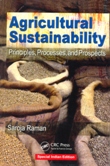
|
AGRICULTURAL SUSTAINABILITY, INDIAN REPRINT - SAROJA RAMAN (EX) |
|
|
Cover Price : Rs 3,995.00
|
Imprint : CRC Press
ISBN : 9781560223108
YOP : 2013
|
Binding : Hardbound
Total Pages : 498
CD : No
|
|
Agricultural Sustainability :Principles, Processes, and Prospects provides a comprehensive examination of all facets of agricultural sustainability, from the evolution of the concept to the today’s state-of-the-art tools and techniques. Challenges to sustainability are clearly presented along with practical strategies to counter prospective problems. This vital resource considers options for the future, as well as reviewing past approaches for their value in today’s world .The book is extensively referenced and includes figures and charts to clearly explain data. Agricultural Sustainability includes a foreword by Dr. M.S.Swaminathan.
Contents
Preface
Acknowledgments
Chapter 1. Introduction
Chapter 2. Agricultural Sustainability: Principles and Paradoxes
Chapter 3. Contextual Nature of Agricultural Sustainability
Chapter 4. Conceptual Framework for Sustainability of Agricultural Production Systems
Chapter 5. Resources and Their Importance for Sustainable Agriculture
Chapter 6. Conservation of Natural Resources and Sustainable Agriculture
Chapter 7. Land Management for Sustainable Agriculture
Chapter 8. Soil Quality and Sustainable Agriculture
Chapter 9. Water Management for Sustainable Agriculture
Chapter 10. Biodiversity and Sustainable Agriculture
Chapter 11. Energy Management for Sustainable Agriculture
Chapter 13. Challenges to Global Agricultural Sustainability
Chapter 14. Achieving Agricultural Sustainability in the Future
Chapter 15. Sustainable Livelihoods and Rural Development
Chapter 16. Summary and Conclusions
Bibliography
Index
|
|
 |
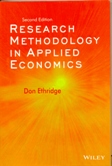
|
RESEARCH METHODOLOGY IN APPLIED ECONOMICS, 2ND ED , INDIAN REPRINT 2014 - DON ETHRIDGE (EX) |
|
|
Cover Price : Rs 2,995.00
|
Imprint : Wiley India
ISBN : 9788126543700
YOP : 2014
|
Binding : Hardbound
Total Pages : 260
CD : No
|
|
This edition of Research Methodology in Applied Economics provides time-tested guidelines to instruct graduate students in the research process and focuses attention on how to organize, conduct, and increase the efficiency of the research process and its outcomes.
Emphasizing research methodology as it applies to economics, Dr. Ethridge provides an overview of the conceptual and philosophical basis of research methodology and (2) procedural guidelines on designing, coordinating, and conducting research projects. This textbook integrates philosophies, concepts, and procedures in research methodology, adding practical tips such as how to write a research proposal, how to apply for funding, and how to write reports that effectively present research. This edition updates and increases the use of relevant examples for today’s students, faculty, and researchers
Research Methodology in Applied Economics, Second Edition gives graduate students the underlying philosophy and principles they must have to successfully negotiate the world of research.
Contents
I. Research Methodology Foundation
1.Introduction
2.Research and Methodology
3.Methodological Concepts and Perspectives
4.Philosophical Foundations
II. The Research Project Design
5.Planning the Research
6.The Research Problem and Objectives
7.The Literature Review
8.The Conceptual Framework
9.Methods and Procedures
III. Closure of the Research process
10.Reporting the Research
IV. Appendices
Appendix A. Example of a Research Proposal for a Government Agency
Appendix B. Example of a Master’s Thesis Proposal
Appendix C. Example of a Ph.D Dissertation Proposal
Appendix D. Guidelines for Critiquing Papers
Appendix E. Seeking Research Funding
References
Index
Don Ethridge, Ph.D., is Chairman and Professor in the Department of Agricultural and Applied Economics at Texas Tech University in Lubbock. He has been a student of research methodology for many years and has extensive experience conducting all types of economic research.
|
|
 |
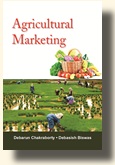
|
Agricultural Marketing - Debarun Chakraborty |
Author |
Debarun Chakraborty
Debasish Biswas
|
|
Cover Price : Rs 1,995.00
|
Imprint : Ane Books Pvt. Ltd.
ISBN : 9789388264495
YOP : 2019
|
Binding : Hardbound
Size : 6.14" X 9.21"
Total Pages : 272
CD : No
|
|
ABOUT THE BOOK
Agriculture is the backbone of the Indian economy. It contributes approx 25 % of National Gross Domestic Product (GDP). In India, agricultural product is the 4th largest exported principal commodity with a share of 10 % of total exports. Over 58 % of the rural households depend on agriculture as their principal means of livelihood. Agriculture, along with fisheries and forestry, is one of the largest contributors to the Gross Domestic Product (GDP). In today’s scenario, agricultural marketing is necessary not only to boost India’s economy but also for the welfare of farmers. It is the economic process through agricultural goods is exchanged. Agricultural Marketing comprises of all operations involved in the movement of the agricultural produce from the producer to the final consumer. Thus, agricultural marketing is a specific part of marketing which is related to agricultural products. There are some measures taken by Indian Government to improve agricultural marketing system in India. The Government of India has introduced the regularized and controlled mandis to protect the farmers from illegal and unhealthy trading practices, gradation of agricultural produce, standardization of weights and measure, establishment of co-operative marketing societies, advertisement of agricultural marketing information, facility of warehouses, stability in price, finance facilities etc.
The book “Agricultural Marketing” has been written for the graduate & post graduate management students of Indian institutions as well as for the institutions outside India who are interested on Indian agricultural market. It clearly explains the fundamentals of the subject and is designed to give an insight to the students with Indian examples. The book is written in simple language so that it can be understood by the students easily. Almost all the topics on agricultural marketing have been covered in this book. The syllabus of the various universities in India has been covered and the book will be useful for the each and every students. Important questions have also been added with this book which supplemented with brief examples of cases for the understanding of the students & academicians.
Dr. Debarun Chakraborty
Dr. Debasish Biswas
ABOUT THE AUTHORS
Dr. Debarun Chakraborty did his BE in Chemical from SIT Tumkur under VTU Belgaum, MBA in Marketing from IEM Kolkata under WBUT Kolkata (presently known as MAKAUT), qualified UGC NET in Management (twice) in June 2012 & December 2012 & completed Ph.D. in Management (Field-Marketing) from Vidyasagar University, Midnapore which is a reputed Government University of West Bengal. He has rich cross functional exposure across various organizations in India for more than 10 years with 8 years in academics & 2 years in industries. He has written five books on Management, presented more than 35 papers in various National & International Seminars & published more than 36 research articles on Management in (few of them are indexed in Scopus) and writing many more. He has won ‘Best Paper’ award for two times in International Seminars, paper setter of various reputed Universities in India, won the “Best Thesis Award (Ph.D.)” for the year 2017 & 2018, Received “Best Researcher Award” in 2017 & 2018, reviewer & editorial board member of various internationally reputed journals (indexed in Scopus & ABDC)
Dr. Debasish Biswas presently serving as an Assistant Professor and Head in the Department of Business Administration, Vidyasagar University, West Bengal. Dr. Biswas has contributed 70 research papers in National and Internal conferences, 40 research papers in National and International journals of repute. He has authored nine books titled: 1. Management Information System, 2. Fundamentals of Financial Management, 3. Industrial Relations & Labour Welfare, 4. The Romance of Human Resource Management, 5. Relationship between Productivity and Industrial Relations, 6. Compensation Management, 7. Human Resource Management for UGC NET, 8. Dynamic Evolution of Management Paradigm (Edited Bok), and 9. Research Methodology for Social Sciences. He received Best Business Academic of the Year Award -2016 (Gold Medal) at the 69 th All India Commerce Conference. He also received Bharat Vikas Award in 2018 in the arena of Management
|
|
 |
|